Barnes & Noble Nook HD+ tablet
Acquired June 2013.
My first Android tablet. Very high-res screen (1920 x 1200), good CPU & GPU, and full access to the Google Play Store with over 700,00 apps avalable, also movies and music.
CPU: Texas Instruments OMAP4470 1.5 GHz
dual core.
RAM: 1 GB
Storage: 32 GB internal flash, plus a MicroSD
card slot supports up to 64 GB,
total 96 GB storage max.
Screen: 9" 1920 x 1200 pixels (256 ppi)
Graphics: PowerVR SGX544
Connectivity: WiFi b/g/n, Bluetooth, USB port, HDMI
OS: Android 4.0.3 (Ice Cream Sandwich)
B&N discontined these tablets so they were being sold at a great price - only $179 for the 32 GB version I got.
The screen is beautiful, bright and at 1920 x 1200 pixel resolution very sharp.
Despite the low price this tablet is not crippled in any meaningful way - it runs HD-resolution 3D games fast, no dropped frames or performance lags. Despite being a Barnes & Noble product it is not locked into the B&N ecosystem. You can install the Amazon book reading app if you want and buy movies from the Google store.
The only features missing are built-in cameras, which I don't miss since a tablet is not exactly the ideal form-factor for taking pictures, and an oleophobic screen coating which means I have to clean-off my fingerprints every couple of days. On the other hand an iPad with 64 GB of storage costs $600; the $421 difference buys a lot of screen wipes (I eventually bought an iPad in 2015).
|
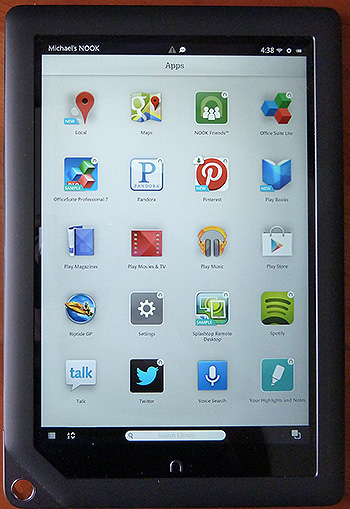
Larger version
|
|
Samsung Galaxy S3 Smartphone.
Purchased
new July 2012.
CPU: Qualcomm Snapdragon S4
dual-core
1.5 GHz Krait, 1 MB L2 cache
RAM:
2 GB
ROM: 16 GB
Storage:
Up to 96 GB maximum of flash memory
32 GB internal plus a
micro-SD
slot
which supports up to 64 GB
microSDXC
cards.
Graphics:
Adreno 225
GPU
Screen: 4.8"
1280 x 720 HD
Super AMOLED
screen,
16 million colors, capacitive
multitouch.
Audio: 16-bit stereo,
44.1 KHz sample rate
Networking: Verizon
4G LTE, 3G
EV-DO,
WiFi
802.11b/g/n,
Bluetooth
4.0,
USB
2.0,
NFC
(near-field communications) and
DNLA (media sharing).
Mobile 'hot-spot' functionality built-in.
Cameras:
Back-facing: 8 megapixel stills, 1080p
HD
movies, built-in LED flash.
Front-facing: 1.9 megapixel stills, 720p
movies.
Other
Hardware: Built-in
GPS
(American system) and
GLONASS (Russian) satellite navigation
receiver, 6 axis motion sensor,
LED
RGB notification light,
mono
speaker, stereo headset jack,
HDMI-out.
O/S: Google
Android
4.4.2 KitKat
This has superseded my
old Android Galaxy S
(see
below) which is now two years old. Just
like between my old Windows phone (also below) and my
original Galaxy, impressive progress has occurred.
In comparison with my old Android phone, this one
has over
double the processing power (1.5 GHz dual
core instead of 1.2 GHz single core), 2.5 times the
screen resolution (921,600
pixels vs. 384,000), four times the memory (2 GB
versus 512 MB) and three
times the maximum storage
(96 GB vs. 32 GB).
Like the original Galaxy
S, this phone has a lower
SAR(radiation) rating than is typically found with the current "super" smart-phones.
The phone originally came with Android 4.0; eventually Verizon upgraded it to 4.4.2 (code name "KitKat") which was released in December of 2013. Currently as of January 2015 there are over one million apps available for the
Android
operating system, and the O.S. is currently installed
over one billion devices.
This phone supports
4G LTE
witch in theory can deliver 20+ megabits-per-second download speed.
|
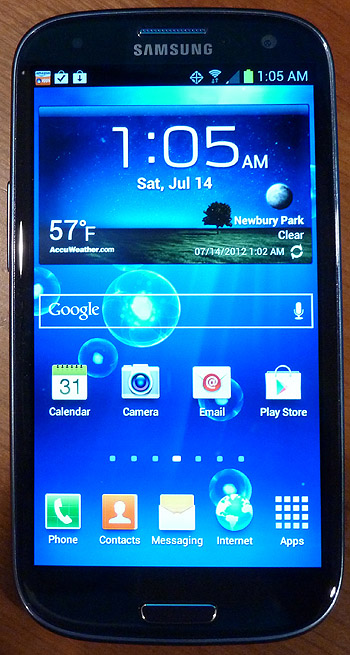
Larger version
|
|
HP Touchpad 16 GB.
Purchased
new August 2011.
CPU:
Qualcomm
Snapdragon
1.2 GHz
dual-core APQ8060 processor
(ARM A8
based)
with 512K L2 cache
RAM:
1 GB DDR2
Storage:
16 GB internal flash memory
Graphics:
Qualcomm Adreno
220
GPU
Screen: 9.7"
1024 x 768
IPS LCD screen,
LED backlighting, 16+ million colors,
capacitive multitouch.
Audio:
Stereo with Beats Audio, two internal
speakers, built-in microphone, head-
phone jack.
Networking:
WiFi
802.11a/b/g/n,
Bluetooth
2.1,
USB
2.0
Camera: 1.3 Megapixels, front-facing for video chat
Other
Hardware: 3 axis motion
sensor
O/S: WebOS
3.0.4
This is my first
modern general-purpose tablet
computer. I couldn't justify spending $500 for an
Apple iPad tablet; but when HP discontinued their
version and sold the remaining stock at very low
prices I couldn't resist. The screen is the same high
quality
IPS panel used for the iPad and is gorgeous
to look at.
The Beats Audio
speakers are a standout feature,
putting out audio with a strength not normally heard
from tablets.
The operating
system WebOS has only been around
for a relatively short time and so there are only
hundreds of apps available, not the hundreds of
thousands that the Apple and Android platforms have.
However the available WebOS apps seem to cover
all the common tablet tasks, such as web browsing,
watching movies, reading emails, playing music,
gaming, etc.
The CyanogenMod folks have a
version of
Android
they have
ported to the Touchpad; currently it is in
the "alpha" testing stage. Apparently it will allow the
user to select either WebOS or Android when the
tablet is booted. Running Android will allow access
to the 300,000+ applications to date written for that
operating system.
|

Larger version
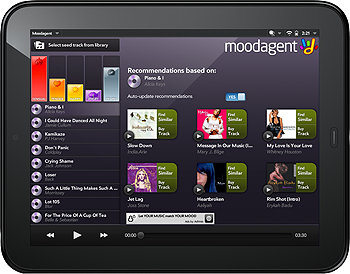
Music
app 'moodagent' running on the
Touchpad
Larger version
|
|
Samsung Fascinate (Galaxy S) Smartphone.
Purchased
new September 2010.
CPU: Samsung 1 GHz Hummingbird
(based
upon the ARM Cortex A8)
RAM:
512
MB
Storage:
2 GB internal flash memory, plus a
16 GB
Micro-SD card
(supports up to
32 GB cards).
Graphics:
PowerVR SGX 540
GPU
Screen: 4"
800 x 480 Super AMOLED screen,
16 million colors, capacitive multitouch.
Audio: 16-bit stereo,
44.1 KHz sample rate
Networking: Verizon 3G
EV-DO,
WiFi
802.11b/g/n,
Bluetooth
3.0,
USB 2.0.
Mobile 'hot-spot' functionality built-in.
Camera: 5 mexapixel stills, HD 720p movies @
30 fps, built-in LED flash.
Other
Hardware: Built-in
GPS satellite navigation
receiver,
6 axis motion sensor, stereo
speakers,
headset jack,
infrared transceiver.
O/S: Google
Android
2.3.5 "Gingerbread"
(originally shipped with 2.1)
This has superseded my
old Windows Mobile phone
(see #3 below) which I used for over two years. In that
time tremendous progress has occurred in cell
phones.
My old phone was considered state-of-the-art when I bought it; in comparison this new phone
has over
double the processing power (1 GHz instead
of 400
MHz), five times the screen resolution (384,000
pixels vs. 76,800), eight
times the memory (512 MB
vs. 64 MB) and sixteen
times the maximum storage
(32 GB vs. 2 GB). Not to
mention features that didn't
exist on my old phone, such as GPS
and a multi-touch screen.
This phone's screen is a
new type of technology called Super AMOLED,
which provides very saturated colors and deep contrast like a
plasma TV (the blacks are
really black, not the usual dark grey). Also the screenuses less power which
gives this phone good battery
life in comparison with other big-screen super phones.
Besides the incredible
screen the other reason I chose
this phone in particular is that it has the lowest
SAR (radiation) rating of any
of the current super phones. This model puts out only
one-third the radiation of the popular Motorola Droid X
while matching or exceeding
it in most areas (the 'X' does have a slightly taller screen and an HDMI
port).
The other fantastic
feature is the large number of application programs
(usually refered to as 'apps') available for the
Android
operating system - over 70,000 currently.
Apps turn what would otherwise just be a device to
make phone calls into a fully-functioningPC that fits
in a shirt pocket.
|
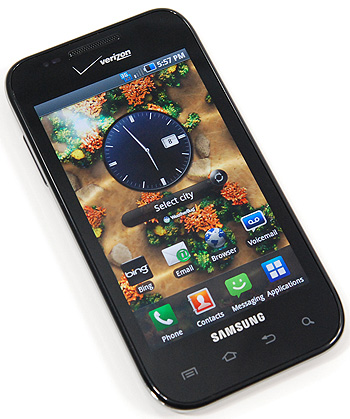
Larger version

|
|
HP Mini 311 Netbook.
Purchased
new September 2010.
CPU:
Intel Atom
N270 1.6 GHz with 512K L2
cache.
RAM:
2 GB (expandable to 3 GB)
Storage:
160 GB 5400 rpm SATA hard-drive,
SD card slot
(supports up to
32 GB).
Graphics:
Nvidia Ion (based upon Geforce 9400M).
Screen: 11.6"
1366 x 768 LCD with LED backlight,
16 million colors.
Audio:
Realtek 2 channel HD with built-in
Altec Lansing stereo speakers.
Networking:
Ethernet 10/100 Mbit, Verizon cellular
modem 3G
EV-DO,
WiFi
802.11b/g/n,
Bluetooth
3.0, also three
USB
2.0 ports.
Camera: Webcam built-in
Other
Hardware:
HDMI and VGA ports
for an external
monitor, also audio in/out.
O/S:
Windows 7 Home Premium
This is my first
netbook. Weighing
only 3 pounds,
it has the footprint of a letter-sized sheet of paper and varies in thickness
from only .78 to 1.2". This
makes it much more easy to carry than my regular
laptop computers, and battery life is also much longer.
The built-in Verizon
CDMA cellular modem allows this machine to be connected while on the road which
makes it handy for providing emergency technical
support to my clients.
The
Nvidia ION-LE chipset
supports playing HD movies and older 3D
games; Portal and Call of Duty 1 run fine but Left 4
Dead does not. Still, this machine's
graphics capabilities are well ahead of most other
netbooks and the HDMI output has allowed me to use
this little machine as a 'Home Theater' PC (streaming
HD content from Amazon's Video On Demand
service) when it is at home.
|
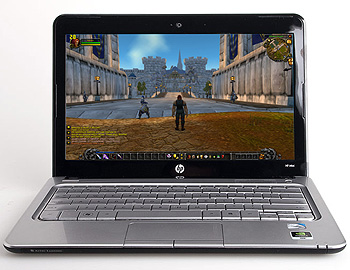
Larger version |
|
ACN Iris 3000 Videophone.
Made circa 2008, purchased
used July 2011.
CPU:
Freescale i.MX27, ARM926EJ-S
400 MHz core.
Memory /
Storage:
Internal memory unknown, USB port and
SD card slot for add-on storage.
Graphics: Proprietary, supports
H.263 and
H.264
video codecs, G.711 and
G.729 audio.
Screen: 7"
LCD screen 800 x 600 color
Audio:
Built-in speaker, handset, audio out jack
Networking:
Ethernet 10/100, USB 2.0
Other
Hardware: Built-in
CMOS camera, video & audio
out ports.
O/S: Customized version of
Linux
Like my Sony Reader (see above), this is another device based upon a
Freescale
SoC ("System on a
Chip") with an ARM CPU.
I purchased this
item for $20. To function as a video phone, a monthly subscription is required which at this point I don't intend to get. I bought this gadget because a) it's cool looking, b) was very cheap and c) it functions as a digital picture frame when idle; it can show photos stored
either on a USB memory stick or an SD card. An actual dedicated photo frame with a 7" 800 x 600 screen would of cost considerably more than I paid for this gadget. The
CMOS camera and video out features also work without a subscription.
More of my airshow
photos can be found here.
|
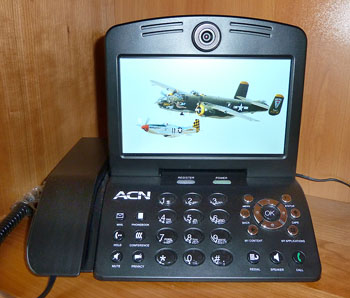
Larger version
|
|
Samsung SCH-i760 PDA Cell Phone.
Purchased
new December 2007.
CPU: Samsung SC32442 400 MHz
32 bit
(ARM920T core).
RAM:
64
MB
Storage:
128 MB internal Flash Memory
2 GB Micro-SD card.
Graphics: Proprietary
Screen: 2.8"
320 x 240 65,000 (16 bit) color
LCD
Audio: 16-bit stereo,
44.1 KHz sample rate
Networking: Verizon 3G
EV-DO,
WiFi
802.11b/g,
Bluetooth 2.0,
USB 2.0
Other
Hardware: Built-in slide-out
QWERTY keyboard,
camera (1.3 MegaPixels), stereo
speakers, headphone jack,
infrared transceiver.
O/S:
Microsoft Windows Mobile 6.0
Professional
This combination 3G PDA & phone
was one of the first devices sold by Verizon
that allowed WiFi connections
in addition to using their cellular network. When using the cell network
for data transfer, speeds up to 2.4 Megabits per second are possible using the
CDMA
EV-DO protocol.
Programs bundled with this
phone included the mobileversions of
Microsoft
Office, Media Player and the
Picsel PDF viewer. It has full support for sending and
receiving emails including HTML formatting and message attachments.
Notable applications that can be downloaded for free
to the phone include Google Maps and
Microsoft Live Search. However, like the original iPhone, this unit is
not equipped with a GPS chip,
so mapping programs
cannot automatically show the current location.
|
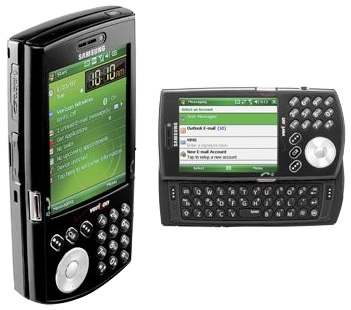
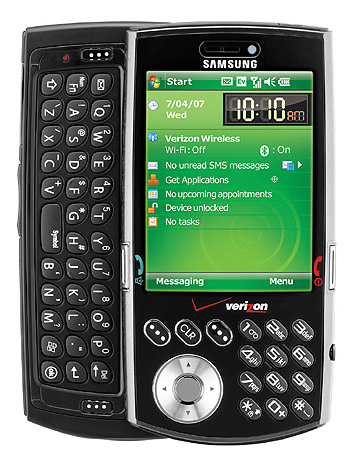
Larger version
|
|
Nokia N800 Internet Tablet.
Purchased
new October 2007.
CPU:
Texas Instruments
OMAP2420
330/400 MHz
RAM:
128
MB
Storage:
256 MB internal Flash Memory
One internal
SD card slot 8 GB max
One external SD card slot 8 GB max.
Graphics:
X-Windows, proprietary chip
Screen: 4.1"
800 x 480 65,000 (16 bit) color
LCD
Audio:
Stereo
Networking:
WiFi
802.11b/g,
Bluetooth 2.0,
USB 2.0
Other
Hardware: Built-in web camera
(640x480), FM
radio tuner, stereo speakers, stereo
headphone jack, mono microphone.
O/S: Linux-based
Maemo
3.2 / Internet
Tablet OS 2007.
Although made two years ago
this portable computer
still has one of the highest-resolution screens available
for something that can fit
comfortably in a coat pocket;
the screen's dpi is
about double that of the
Apple iPhone
(2007 edition) or Touch.
It can connect to the Internet either
with WiFi or via
Bluetooth through a compatible cell-phone.
Unlike most portable devices, the operating system is
an open platform based upon Linux. Being open
means that anyone is allowed to write software for
the device, and in fact a large collection is already
available, much of it free (see
www.maemo.org).
The list of tasks this little computer can do out-of-the-box is impressive; it comes with programs for
browsing and searching the web, playing music and
movies, listening to Internet radio stations, viewing
photos (the external flash slot accepts both SD and MMC camera cards), making
VOIP phone calls
(Skype), instant messaging, sending and
receiving
email, and so on. There is even an applet included
for video-conferencing using the built-in webcam.
The built-in Bluetooth supports a wide range of
wireless accessories such as stereo earphones and
even keyboards.
My primary reason for purchasing this unit was the
super high-resolution screen. I looked at the Apple
iPhone, but even though it has the best screen
of any cell phone, I found it still to be a bit of a strain
to view web pages. The Nokia has double the
horizontal resolution of the 2007 iPhone's screen, and it
does make a difference. The primary drawback of
the Nokia tablet is that in areas with no WiFi
coverage it does need to pair with a cell phone to get online.
It even has a kick-stand! This is another nice touch,
most pocketable devices need to be held in the hand
or propped up on something to watch movies.
|
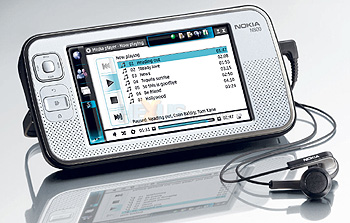
Larger version
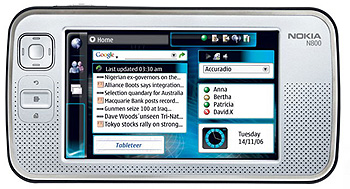
Larger version
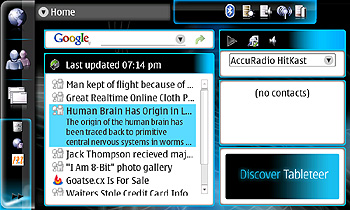
Larger version
|
|
Sony PlayStation Portable (Model PSP-1000).
Purchased
new April 2007.
CPU:
MIPS R4000 333 MHz
32-bit
RAM:
32 MB plus 4MB embedded DRAM
Storage:
Internal
UMD (optical drive) – 1.8 GB per
disc.
Internal
Memory Stick slot – 2 GB card.
Graphics:
MIPS R4000 core, capable of 664 million
pixels / 35 million polygons per second.
Screen:
4.3" 480 x 272 16.77 million color
LCD
Audio: Stereo with built-in speakers
Networking: USB 2.0 and
WiFi
802.11b built-in
O/S: Proprietary
This is my second PSP-1000, purchased after the price dropped to $169. I wanted a second one so that
I
could run Sony's latest firmware; my original unit (see
below) cannot be upgraded since it would then loose the ability to run homebrew programs.
With Sony's latest firmware, the PSP can be used as
a wireless web browser, it can stream multimedia
content and games via WiFi from a Playstation 3,
and (finally!) user-created video clips can be played
from memory sticks at full resolution (the photo I took
at right shows the unit playing back
ATI's 'Ruby' video).
|

Larger version |
|
Dell Axim X51v Pocket PC.
Purchased new April 2007.
CPU: Intel
XScale PXA270 624 MHz
RAM: 64 MB
Storage: 256 MB
Flash memory, plus Compact-
Flash and SD slots for additional
storage.
Display:
3.7" LCD TFT 640x480 resolution
touch-
screen, 16-bit color.
Graphics:
Intel 2700G chip with
16 MB video
memory, dual display support.
Audio:
WM8750 sound chip with 16-bit stereo,
44.1 KHz sample rate. Output is via
stereo headphone jack or mono
speaker. There is also a built-in
microphone with full duplex recording &
playback.
Networking:
WiFi 802.11b and
Bluetooth
wireless
built-in, plus USB.
Misc:
CompactFlash Type II
and
SD
/ SDIO Now! / MMC card slots,
VGA output for external monitor,
also infrared transmitter/receiver.
O/S:
Microsoft
Windows Mobile 5.0.
This is the last and most advanced
Pocket
PC made by Dell; they pulled-out of the PDA market in April '07. As such it makes an appropriate bookend to my old Axim X5 (see
below), which was Dell's first PDA introduced back in 2003.
The X51v was one of the few Pocket PCs ever built with a high-resolution screen (640 x 480 pixels);
this display had about four times the resolution typically found on other
PDAs or PDA/phones for the time (2007).
SciFi fans: This model PDA and my Dell
Inspiron laptop (#22, below) were frequently seen on the television series Stargate
Atlantis.
|
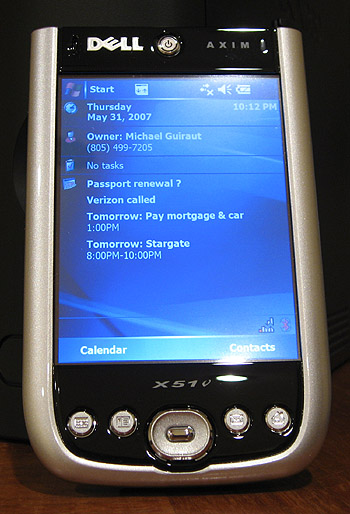
Larger version |
|
Toshiba HD-DVD player (model HD-A1).
Purchased new June 2006.
Why is a DVD player
on a list of computers? Normally
it wouldn't be, but this particular
player, the first
machine sold that was able to play
High
Definition DVDs,
is in fact under the hood a Pentium 4
computer with 1 GB of RAM, running RedHat Linux.
CPU:
Intel
Pentium 4
2.5 GHz
RAM: 1 GB PC2700 DDR (one slot).
Storage: NEC HD-DVD
drive, IDE interface,
compatible with 15 GB and 30 GB
HD-DVD optical discs (also
backward
compatible with the common DVD and
CD optical formats).
Dedicated 256 MB Flash drive for
operating system.
Graphics: Proprietary, HD video 1080i with
HDMI and component outputs.
Networking: Ethernet, one
port, speed unknown.
Misc: 2 USB 2.0 ports.
O/S: RedHat Linux
(boots from flash drive)
Further info and photos of what's inside are
available
here.
It's been reported that this unit is costing
Toshiba more
to make than what they are selling it for.
Update 12/06: At the end of 2006 I
acquired the
Microsoft HD-DVD drive for my
Xbox 360 (see below).
Update 1/09: The HD-DVD format was
discontinued
a year ago (February '08). At that time I bought a third
player at a close-out price, a
Toshiba HD-A35.
Note
that unlike my HD-A1, this final generation player is a
more conventional consumer electronics unit, not a
PC in sheep's clothing.
While the format has been discontinued, Amazon continues to sell
HD-DVD titles at a considerable
discount.
|
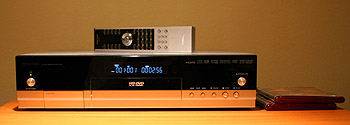
Larger version
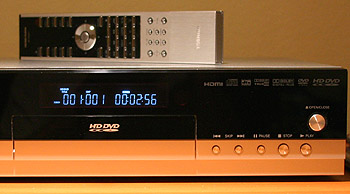
Larger version
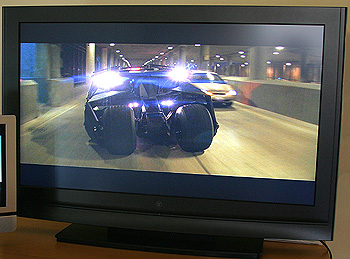
"Batman Begins"
HD-DVD playback on 42" LCD-TV
Larger version
|
|
Home Theater PC Project.
Built April 2006.
Note: This project has been scrapped due to the failure of the proprietary motherboard that came with the special transparent case. The major components were recycled to build a new computer for my wife in a more traditional case.
Update: For home theater streaming content, we got a Google Chromecast back in 2013, and then in December of 2014 we acquired a TV that connects directly to Internet content services such as Netflix.
Update 2023: In the past eight years we have stopped using the Chromecast devices and now use Amazon Fire Sticks and the Fire Cube for streaming video.
CPU:
Intel Pentium 4 3.06 GHz CPU with
Hyper-Threading
RAM: 1 GB -
Corsair XMS
ProSeries low-latency
(CL2) DDR400. One slot still available
(system maximum is
2 GB).
Chipset: Intel i845GE
Storage:
Western
Digital WD3200 320 GB ATA 3.5”
drive; Shuttle
silver internal DVD burner.
Graphics:
PNY
Geforce 6600 256 MB DDR AGP card
Networking:
Ethernet 10/100
Megabit
Misc: 4 USB 2.0 ports, 3
Firewire, optical audio
in/out
O/S:
Windows
Media Center 2005 Edition
and Fedora Core 5 Linux (dual boot
set-up).
Notes:
Based upon the
FIC
VG61 ‘Ice Cube’ small-
form-factor (SFF) chassis
and motherboard.
The
Hyper-Threading feature of the
Pentium 4 3.06
GHz chip appears to Windows as a
second CPU.
With hyper-threading, some processes
(such as
media
encoding) show improvements in
performance
from 10% to as much as 30% faster.
Windows Media
Center is the
home-theater-PC
version of XP. Linux was also installed to support
using MythTV, a free DVR (Digital Video Recorder)
package.
These two photos show where I
started; the first
photo shows the bare-bones chassis
with no
drives or CPU; the second how things
looked with
the CPU and fan installed.
12/06 Update: Arrggh!
The FIC motherboard died,
putting this machine out of commission. I am going
to have to rebuild using a different motherboard,
probably also a new case (the small FIC case is
pretty but has thermal problems, as in even with
three fans some of the components get too hot).
10/08 Update: Decided it was
time to resuscitate
this project. Accordingly, I acquired a micro-ATX
motherboard (see
photo at right) which is compatible
with the components I plan on salvaging from the 1.0
version of this project (socket 478 CPU, DDR400
memory, AGP graphics card, etc.). Still need to get
a new case and power supply...
1/09 Update: At
low cost picked-up a
Cooler Master
Elite 340 mini-tower case and an
Antec 500 watt
power supply. Now I just have to find the time to
assemble everything together.
|

Larger version
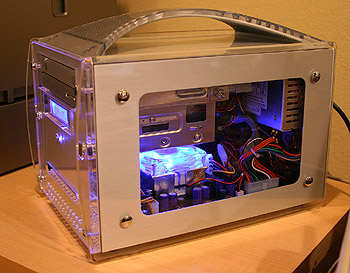
Larger version
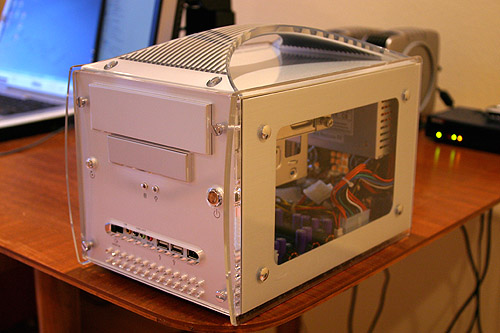

Larger version Larger version
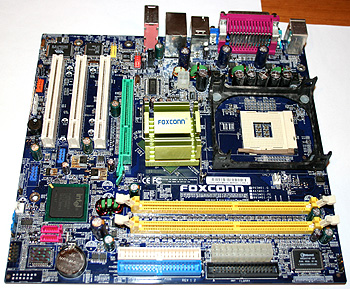
New
motherboard - a
Foxconn
865M01-G-6ELS
Larger version
|
|
Microsoft Xbox 360 Premium.
Purchased
new January 31st, 2006.
CPU: IBM 3.2 GHz
Power Xenon Triple-Core
(1 MB L-2 cache,
165 million transistors
total)
RAM: 512 MB GDDR3 (700 MHz)
Storage: 120
GB SATA 2.5” drive
Internal DVD-ROM
drive (12x CAV)
Two slots for
optional 64MB memory
units.
External
HD-DVD (high definition) drive
Graphics:
ATI 'Xenos' GPU (500 MHz, 332 million
transistors) HDTV
resolution (up to
1080i).
Audio:
Dolby Digital Surround
5.1
Networking:
Ethernet 10/100
Megabit
Misc: 3 USB ports, wireless game controller,
wireless media
remote, wired audio
headset.
O/S: Microsoft proprietary (reportedly it is
a descendant of the
old Xbox 1 OS,
which was based upon a
stripped-down
version of Windows 2000).
This is the second-generation
game console from
Microsoft; optimized
for high-definition gaming. The
IBM CPU has
three symmetrical cores, all running
at 3.2
GHz (in contrast, two-core CPUs were just
becoming available for higher-end PCs in 2006). The
Xbox
360 CPU is capable of one trillion
floating point
operations per second (commonly referred to
as a
‘teraflop’). The custom
ATI graphics processor
is supposed to be able to
pump out as much as
500 million triangles
per second; in comparison, the
old
Nvidia TNT card in the desktop system I built in
’98 (see below) is capable of only 6 million
triangles
per second.
The 360 has replaced my
old Xbox 1 (see entry
below) in my home
theater set-up. The photo at right
shows
it in place, with the wireless controller and
media remote.
The TV it is connected to is a Hitachi
50V500
High
Definition set purchased way back in
2003; it is a
LCD rear-projector unit with a 50"
screen and a
native resolution of 1366x768.
This photo shows how ‘Call of
Duty 2’ looks on the
360 connected to the
Hitachi TV. No photo however
can
really do it justice - in this scene, snow is
gently
falling, and thanks to the Dolby 5.1
surround track
you can hear all around you the crackle of gunfire,
the dull heavy thumps of shells
landing nearby and
even the occasional
scream as someone gets shot.
Very immersive – so much so that after a short
while you
can imagine that you are really there,
fighting street by street in the snow on the Russian
front.
The last photo is a screen shot of
the Xbox 360
version of ‘Far Cry’. The jungle and water look
amazingly realistic; so
much so that it makes me
want to go on vacation
right away to some beautiful
tropical
island.
This system also does a great job as a
low-cost
'Media Center' system - it can stream a
variety of
PC-based media content, from
MP3s to
Amazon
Unbox movies.
Update
12/2006: Added Microsoft's new out-board
HD-DVD (high definition) drive to
system.
Update 7/2007: Replaced 20 GB hard drive
with
the new Microsoft 120 GB drive.
|
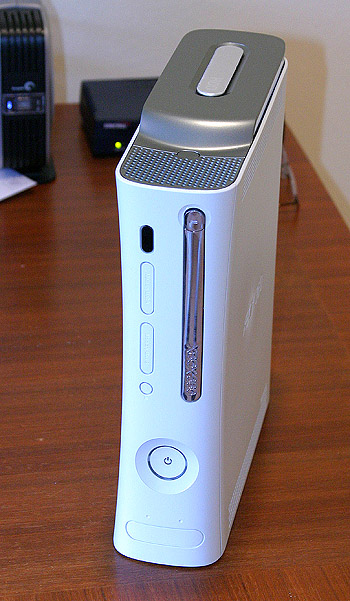
Larger version

Larger version
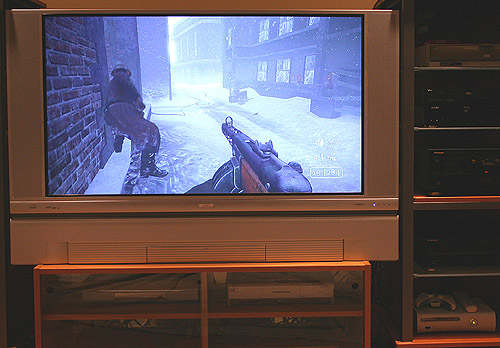
"Call of Duty 2" game Larger version
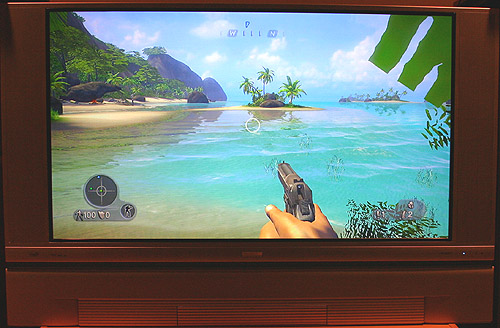
"Far Cry" Larger
version
|
|
Dell Inspiron 9300 Laptop with 17” wide-
screen display.
Purchased new March 2005.
CPU: Intel
Pentium M 760 2 GHz
"Dothan"
with 2 MB L2 cache.
RAM:
2 GB (maximum capacity)
Storage: Internal 60 GB 7200 rpm hard drive
Internal
DVD+/-RW
dual layer burner
External Seagate
300 GB Firewire drive
External Seagate
400 GB Firewire drive
Graphics:
Nvidia Geforce Go 6800 with 256 MB
VRAM.
Supports dual displays (DVI or
VGA connection).
Display:
17" LCD WXGA+ 1440 x 900 resolution
Networking:
Ethernet 10/100, WiFi (802.1a/g)
and
Bluetooth.
O/S:
Windows XP Professional SP2
Notes: This machine served as my main
computer until
January 2007, when it was replaced in that
role by the result of my "new business PC"
project (see above). The photo at
right shows
the office as it looked in early 2006.
This laptop
was one of the first ones built on Intel’s
Sonoma
architecture,
which brought the PCI Express bus
to laptops. The machine has numerous USB 2.0 ports, Firewire,
an SD card reader, DVI port and a built-in
sub-woofer.
The 256 MB
Geforce video card
gives this laptop the graphics performance of at
least a
mid-range desktop PC, allowing this machine to play 1080p HD video
clips and
intensive graphical games such as Far Cry. An
external LCD
panel can be connected to the DVI port to provide dual
displays as shown in the photo at upper right.
Most older laptops support simple
mirroring of the primary display on an external
monitor; in contrast the 9300 can actually use the
external display to show additional content
such as
a video full screen or an
extended Windows
desktop.
Update 6/12: Increased installed memory from 1 GB
to 2 GB.
|
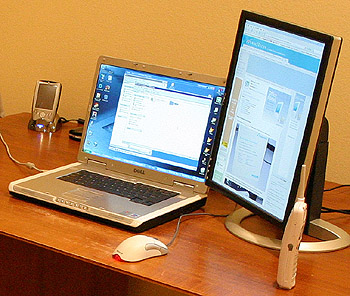
Larger version
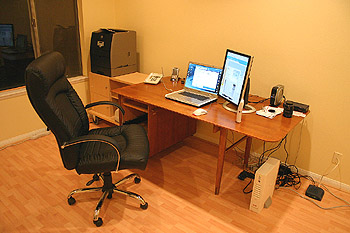
Larger version
|
|
Dish Network 942 high definition receiver &
digital video recorder (DVR).
Purchased new in 2005.
CPU:
MIPS64 300 MHz, 64-bit embedded
RAM: 64-bit
DDR 400 MHz, probably 64 MB in
size.
Storage:
Internal
Western Digital 250 GB 7200
rpm
SATA
hard drive.
Networking: Ethernet,
modem port.
Special
Hardware: Three HD tuners (two
satellite, one
OTA).
Two remote controls, one UHF,
the other
infrared.
Misc: DVI,
component video,
also USB 2.0.
O/S:
Linux (GLinux
modified kernel)
Notes: Like my
HD-DVD player, this home enter-
tainment
device is actually a
Linux computer
'under the hood'.
The official spec sheet is
here. More
info on the chips used in the 942, plus some photos of the inside are
available here.
Update: I discontinued my Dish subscription a few years ago so this box is no longer in use.
|
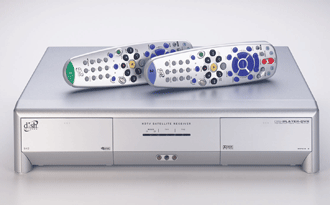
Larger version |
|
Two Sony PlayStation Portables
(Model PSP-1000).
Purchased
new in 2005.
CPU:
MIPS R4000 333 MHz
32-bit
RAM:
32 MB plus 4MB embedded DRAM
Storage:
Internal UMD (optical drive) – 1.8 GB per
disc.
Internal Memory
Stick slot – can use up
to 1 GB cards.
Graphics: MIPS R4000 core, capable of 664 million
pixels / 35 million polygons per second.
Special
Hardware: 4.3" 480 x 272 16.77 million color
LCD
screen
USB 2.0 and WiFi
802.11b built-in
O/S: Proprietary
Notes: Bought for entertainment
purposes; also as a
device for carrying and displaying digital photographs
and movie clips produced by my Canon Digital
and Panasonic DV cameras. The screen is very
impressive,
by far the best I have ever seen on a
hand-held device (as of 2005).
This original unit has the 1.5 firmware, which was the
last version easily hacked (there is a
thriving
community of folks who have written 'homebrew' applications for the PSP.
|
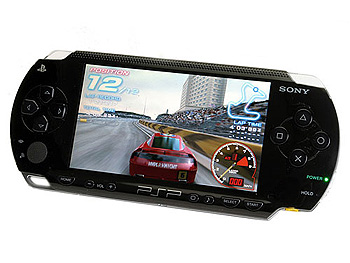
Larger version
|
|
Intermec 750 Color
Mobile Computer.
Acquired September 2003.
CPU: Intel
XScale 400 MHz
RAM:
64 MB
Storage: 64 MB of Flash ROM
SD and
CompactFlash Type II
card
slots
allow additional storage to be
added.
Display: 3.8"
Transreflective (daylight readable)
LCD
320 x 240 pixels 256,000
colors.
Audio: Mono with built-in speaker &
microphone,
headset jack.
Networking:
WiFi 802.11B and Bluetooth
transceivers.
Ethernet can be added with optional
CompactFlash I-O card.
Also supports optional cellular modem
(GSM/GPRS or
CDMA/1xRTT).
Special
Hardware:
Laser
Barcode scanner built-in,
Backlit keypad,
Lithium-Ion 14.4 watt-hour battery, 8-12
hour life.
OS: Microsoft
Windows for Pocket PC 2002
Notes:
This rugged industrial handheld computer
can survive repeated drops (5 feet to concrete), is water
and dust resistant and can operate in temperatures
from -4 to 140 degrees F. It's
primarily designed for
warehouse and inventory data collection
applications
with the
built-in laser barcode scanner and WiFi
connectivity.
There is a good
range of development tools available
for this system, including
Microsoft Visual
Studio and
a stripped-down version of
SQL Server that is
designed to run on mobile devices.
|
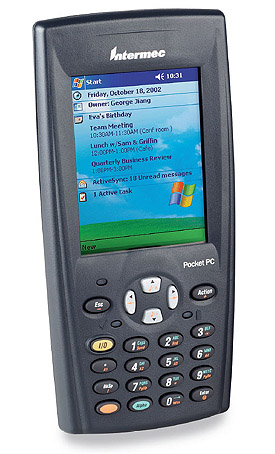
|
|
Apple iMac G4 17".
Built in 2003; acquired July 2011.
CPU: Motorola
PowerPC G4
(7455)
1 GHz
processor with 256K L2 cache.
RAM: 1.25 GB
Storage: Seagate
Barracuda
ST380023A
80 GB
7200 rpm
Ultra ATA-100 drive.
Pioneer DVR-105 DVD-RW/CD burner
Graphics: Nvidia
Geforce4
MX
AGP with 64 MB
VRAM.
External VGA port (mirror only).
Monitor:
Built-in 17" LCD Display, 1440 x 900
pixels resolution, 24-bit color.
Audio: 24-bit Stereo input and output
Networking: 10/100 Ethernet,
also 56k v.92 analog
modem built-in. Available slot for Apple
Airport
Extreme card.
Misc: USB 1.1 &
Firewire
400 ports
O/S: OS X 10.4 (Tiger)
This is my second iMac - the first
was an older G3
iMac with a CRT screen (see #31 on my
Antiques
page). It originally came with OS X 10.2; I upgraded
it to 10.4 (Tiger).
I now have eight working Macintosh computers:
Mac SE - 68000 8 MHz CPU (built 1987)
Mac Performa 466 -
68030 33 MHz (1993)
Power Mac 9500 - PPC 604 132 MHz (1995)
iMac
DV SE G3 - 400 MHz (1999)
Power
Mac G4 - 400 MHz (2000)
Power Mac G4 MDD - Dual 1 GHz (2002)
iMac
G4 - 1 GHz (2003)
iMac
Intel Core Duo - 2.4 GHz (2007)
I also have an old IIe Platinum, an IIc and a Newton,
for a grand total
of ten Apple computers so far.
The excellent
Apple History site has detailed info on
the iMac G4
here.
7/16/11: Installed
an 1 GB SO-DIMM to increase the
memory from the original 256 MB to 1.25 GB.
|
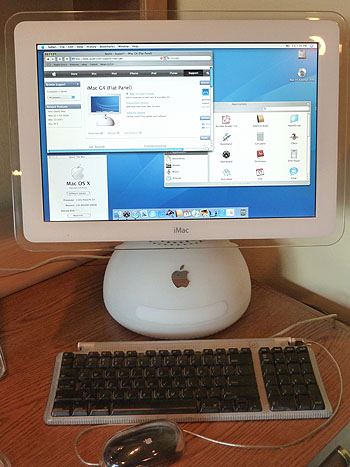
Larger version
|
|
Dell Precision
Workstation 450.
Built in 2003; acquired November 2011.
CPU:
Intel Xeon 2.4 GHz with
hyper-threading
and
512K L2 cache;
socket
available for second CPU.
RAM: 2 GB
ECC expandable to 4 GB
Storage:
Seagate
Cheetah
73 GB
15,000 rpm
SCSI
drive model
ST373453LW,
Samsung
SM-348B 16X / 24X / 48X
DVD-ROM / CD-RW
/ CD-R burner,
NEC 3.5" floppy drive.
LSI Logic Ultra 320
SCSI card
with
external
high-density SCSI port.
Graphics:
Nvidia Quadro FX 1000 Professional
Graphics card with 128 MB of VRAM
and two DVI ports (supports dual
monitors). Up to 3840 x 2400 pixels
resolution on a singe display, or 1600 x
1200 on dual displays.
Audio: SoundMax
Integrated Digital Audio
(AC97 stereo 16 bit)
Networking: Intel Gigabit Ethernet
Misc: One
PCI-X 64-bit slot, two PCI 32
bit
slots, one AGP Pro slot.
Four USB 2.0 ports.
O/S: Windows XP
SP3
This machine was designed for
professional use in
the fields of CAD/CAM, graphic design, etc. As a
result it has a lot of higher-end tech that consumer
PCs usually lack, such as
error-correcting memory,
a hard drive that spins at 15,000 rpm (consumer
drives usually range from 4,000 to 7,200 rpm), not to
mention a server-class Intel Xeon CPU and an
available socket to add a second CPU.
The Intel
Xeon CPU is designed for use
in work-
stations and servers. The version in this machine
is a member of the "Prestonia" family, and supports
multi-processors (more than one CPU in a system)
plus hyperthreading (two threads can be executed
per CPU). The Workstation 450 supports two CPUs;
this is similar to
today's dual-core CPUs but in dual-
core both processors share the same die. Since
Xeon supports hyperthreading, with two CPUs
installed up to four threads can be executed simul-
taneously.
The
Nvidia Quadro
FX 1000 is my first "professional"
graphics card. While similar hardware-wise to
consumer versions, professional graphics cards
have firmware that emphasizes drawing accuracy
over pure speed. Up to 3840 x 2400 pixel resolution
is supported for a singe display, or 1600 x 1200 on
dual displays. The GPU is based upon the NV30
Geforce FX and supports DirectX 9 and OpenGL 2.0.
The card also features an output port for 3D stereo-
scopic viewing, intended for engineering and
scientific
applications.
So far I have only
tested the card with some
consumer-style applications such as playing back
videos and gaming. The card appears to have no
trouble playing 1080p video and older games such
as Call of Duty 1. On the other hand, it couldn't
render the graphics properly in the recent game "Left
for Dead", but this is not surprising considering the
age of the card.
Links:
GPUReview
page on the Quadro FX 1000
|
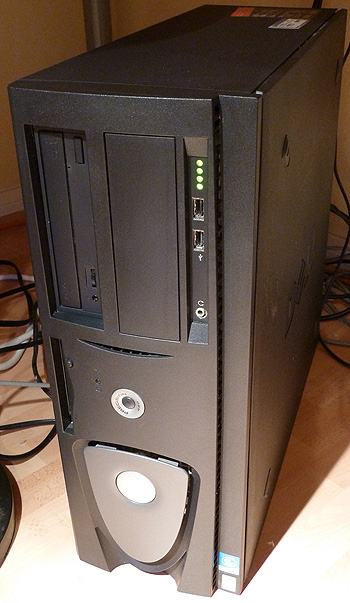
Larger version
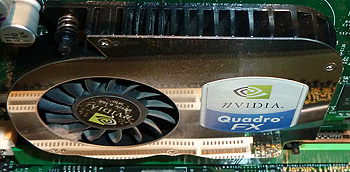
Quadro FX Professional Graphics card
Larger version

Opened up
Larger version
|
|
Dell Axim X5 Pocket PC. This
color PDA was
purchased new in early 2003.
CPU: Intel XScale 400 MHz
RAM:
64 MB
Storage:
48 MB ROM for system software, 1 GB
flash memory (SD card).
CompactFlash
slot also built-in.
Display:
3.5" 65,000 color 320 x 240 pixel
touchscreen.
Audio: Stereo sound via headphone
jack, also
mono speaker and microphone.
Misc: Infrared
transceiver
Special
Hardware: Two Compact Flash accessory cards,
a Wifi 802.11B adapter and a GPS
receiver (see update info below).
OS: Microsoft Windows for Pocket PC 2002.
Update 12/06:
I turned this unit into a low-cost hand-
held GPS navigation system by adding
a
GlobalSat BC-337 GPS receiver card
(see
photo at right)
and Microsoft
Pocket Streets software.
|
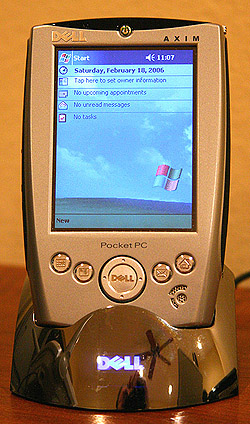
Larger version
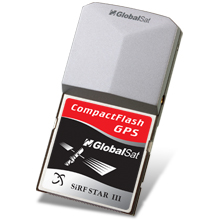
|
|
Microsoft Xbox. Purchased
new in 2003.
CPU: Intel
Pentium III 733
MHz 128KB L2
RAM:
64 MB DDR SDRAM
Storage: Internal 8 GB 5400 rpm
hard drive
Internal
DVD-ROM drive
Memory card slot (8 MB proprietary)
Graphics:
Nvidia NV2A Graphics Processor
(125
million polygons per
second)
- supports up to
HDTV (1080i)
resolution for
games.
Audio:
Dolby 5.1 Game & DVD play-back.
Networking: 100
Megabit Ethernet
Accessories: Microsoft wired
controller
Logitech wireless controller
Xbox DVD Movie Playback Kit (infrared
receiver dongle and matching remote
control).
High Definition AV Pack
MadCatz MC2 Racing Wheel for Xbox
O/S: Reportedly a stripped-down version of
Windows 2000.
Purchased
after the price dropped from the
original $300 price down to $150 with several games bundled in. This was the first game console I ever owned (I now have at least eight in my collection).
Bought to connect to my HDTV for
gaming– however only a few Xbox games actually support HD
resolutions. Games that can do at
least 480p (progressive scan) look surprisingly sharp. I have one
game that supports 720p and the increased detail is
clearly visible. This machine is
however quite noisy;
it sounds like a small vacuum cleaner when running! Hopefully the upcoming Xbox 360 will be
quieter; it’s
also
supposed to have better support for HD gaming.
Update 1/31/06: I now have a new Xbox
360 in the
house; this old Xbox
“1” has been
moved to the bedroom. Sadly, the
360 is not quieter than the original
Xbox.
Update 12/6/08:
Picked up a used MadCatz MC2
Racing Wheel and pedals for $8.
|
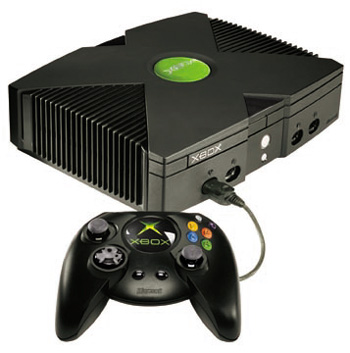

Halo 2 screenshot (from Bungie)
Larger version
|
|
Three (3) Compaq Evo D500 Small Form Factor PCs.
Built circa 2002; purchased used in February and March 2009.
Machine #1:
CPU:
Intel
Pentium 4 1.7 GHz 256K L2 cache
RAM: 576 MB SDRAM PC133 (expandable to
3 GB)
Storage: 30
GB Hitachi Deskstar
Ultra ATA/100
7,200 rpm hard drive.
LG CED-8080B
CD-R/RW 32x/8x/4x
optical drive.
O/S:
Windows XP SP3
Machine #2:
CPU:
Intel
Pentium 4 1.7 GHz 256K L2 cache
RAM: 1 GB SDRAM PC133 (expandable to
3 GB)
Storage: 20
GB Maxtor D740X-6L
Ultra ATA/133
7,200 rpm hard drive.
Lite-On LTN-486S 48x
CD-ROM
drive.
O/S:
OpenSUSE Linux
11.2
Machine #3:
CPU:
Intel
Pentium 4 1.8 GHz 256K L2 cache
RAM: 512 MB SDRAM PC133 (expandable to
3 GB)
Storage: 20
GB Seagate
Barracuda ST320011A
Ultra ATA/100
7,200 rpm hard drive.
HP GCR-8483B 48x
CD-ROM
drive.
O/S:
Drive currently
blank - case has
Windows
XP COA sticker with activation
key which
allows OEM version to be
legally installed.
All Systems:
Chipset:
Intel 845
Storage:
3.5" Floppy drive (1.44 MB)
Graphics:
Nvidia
Vanta (TNT)
with 16 MB RAM in
low-profile AGP 4x slot,
capable of
1600 x 1200 pixels at millions of colors.
Audio: Integrated
AC'97 Stereo with line in/out,
also front-panel microphone, built-in
speaker and a headphone jack.
Networking: Integrated Intel PRO/100
Ethernet 10/100
Misc: 2
half-length, full-height
PCI slots,
4 USB 1.1 ports,
serial port,
parallel printer port.
Notes: Bought
all of these working machine used for less than $200 total; original retail price was around $1,200 each in 2002. I intend to use these systems as
Lightwave
3D render nodes; also to explore alternative PC operating systems such as Linux.
The case of this
model is very
compact at 14" by 13" by 4" high, but it's built like a
tank with a lot of metal
parts. The drives are mounted
internally on a special
tray that pivots up 90 degrees to give easy access to
the memory slots underneath (see photos at right).
Besides their small footprint, these machines need
only a moderate amount of power to run (200 watts
each) and their P4 CPUs support SSE2 which is required by the latest version of Lightwave.
|

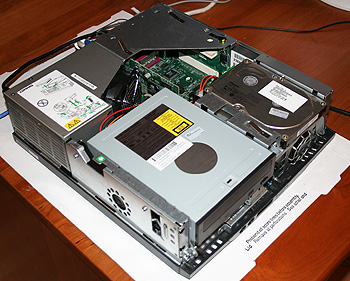
With cover off (Larger version)

With drive tray tilted up (Larger version)
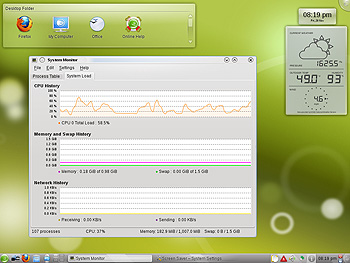
OpenSuse
Linux running on Machine #2
Larger version |
|
Apple Power Mac G4 MDD (Mirrored
Drive Doors model).
Built circa 2002; acquired January 2011.
CPU: Dual Motorola
PowerPC G4
(7450)
1 GHz
processors with 1 MB L3 cache
each.
RAM: 1.25 GB (expandable to 2 GB)
Storage:
One Seagate Barracuda IV 80 GB 7200
rpm Ultra ATA-100 drive.
One Quantum
Fireball 60 GB ATA
drive
Internal
Superdrive DVD/CD burner
Graphics:
ATI Radeon 9000 Pro
AGP card with
64 MB VRAM,
supports dual monitors
with
ADC and
DVI
connectors.
Monitor:
Apple
23" Cinema HD LCD Display
(1920 x 1200 resolution).
Audio: 16-bit Stereo input and output
Networking:
Gigabit
Ethernet,
also 56k v.92 analog
modem built-in.
Misc: Four 64-bit PCI slots, Adaptec
Ultra SCSI
card, USB 1.1 &
Firewire 400 ports.
O/S: Currently OS X 10.5
Leopard
This is my second G4 Mac - the
first (see below)
is an older 400 MHz single processor model. I also
have a iMac G3, PowerMac 9500 and a very old Mac
SE from 1987 - see my
Antique Computer Collection
page for details on these systems.
Released in August of 2002, this Power Mac
featured
dual CPUs standard and a faster bus speed. Known
as the "MDD" model due to it's mirrored drive doors,
it was the last major Power Mac G4 model, the last
one featuring Apple's translucent design motif, the
last one with five expansion slots (1 AGP, 4 PCI),
last one with easily upgradeable CPUs and the last
Power Mac still able to run
OS 9.
I have to admit I like Apple's translucent
designs more
than the current metallic look that they introduced with
the 2003 G5; along several Power Macs I also have
a couple of matching translucent Apple Studio
Displays (see below) and the gorgeous
translucent white Apple keyboard that was only available for a
limited time.
The excellent
Apple History site has detailed info on
the MDD Power Mac
here.
In May 2011 I
picked-up a used Apple 23" Cinema HD
display for this system (see photo at right). This flat-panel display cost $2,000 when new and is packaged
in a beautiful clear case with chrome trim; with the
17" version I got in 2008 these may be the best-
looking pieces of computer gear in my collection.
Like the 17" model, this display uses the proprietary ADC (Apple
Display Connector), which carries both
video and power in the same cable. This means that
the computer's video card directly supplies the
electricity for the monitor to operate; luckily both of
my G4s came with the special video cards required
for this to work.
Other peripherals: I have an
Epson Stylus Photo 1280
large-format 13" x 44" printer (see picture at
lower right) and an old
HP Scanjet 6100C Professional Series SCSI scanner. This scanner, given to me by
another nice client, is about ten years old but is a
rugged heavy-duty professional model. HP's best
desktop scanner at the time, it has a larger than
usual scan area of 8.5" x 14", 30-bit color /
10-bit
grayscale imaging and cost around $1,000 when
new.
9/24/11 update:
Acquired used copy of Apple Final Cut Pro Studio with
matching color-coded keyboard
for this system (see pic at right).
|
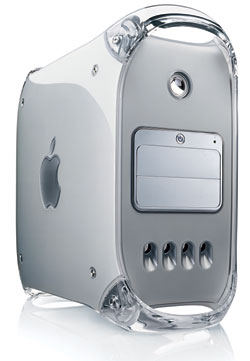
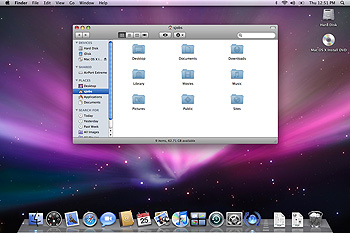
OS X 10.5 desktop
Larger version
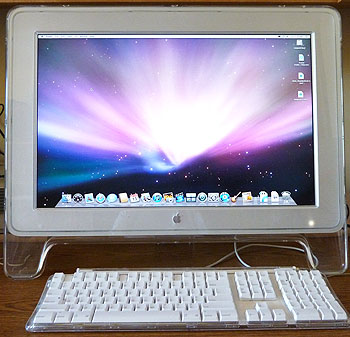
Apple 23" Cinema HD display
Larger version
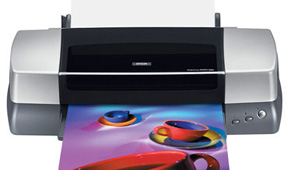
Larger version
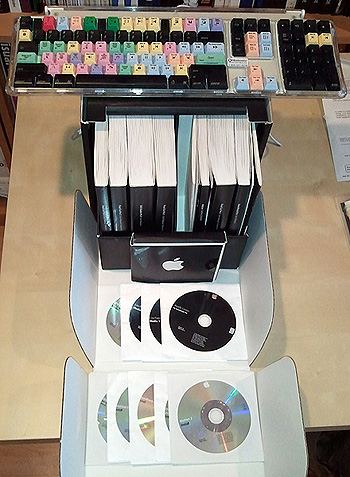
Apple Final Cut Studio
Larger version
|
|
Two (2) Wyse WT3235LE Winterm Thin Client systems.
Built circa 2002; purchased used in February 2009.
CPU:
x86 compatible 300
MHz, probably a
National Semiconductor
Geode GX1.
RAM: 64 MB
Storage: 32
MB flash memory
Graphics: Up to 1280 x 1024 x 16 bit color, VGA
out.
Audio:
AC'97 16-bit 44 KHz stereo
with speaker
and microphone jacks.
Networking: Integrated
Ethernet 10/100
Misc: Keyboard with
mouse port built-in,
4
USB
ports on system, supports USB
printers.
O/S:
Windows CE .NET 4.10
(build 486.4)
Notes: Picked-up these
thin client boxes for
$10 each. A thin-client is a
stripped-down lightweight appliance computer that is used to connect to larger computers
or the Internet. This particular model is tiny at only
7.5 by 6 by 1.7 inches high and
comes with the
following software built-in:
Microsoft
Internet Explorer
Microsoft
RDP client
Citrix ICA client
Terminal emulation for a variety of
terminals such
as the
Wyse-60,
IBM TNxxxx series, DEC VT420,
etc.
ELO Touchscreen support
Product Datasheet (pdf)
|
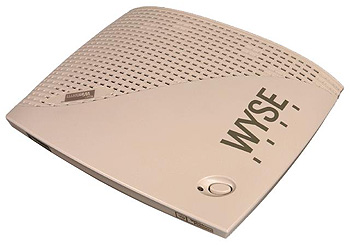
Larger version
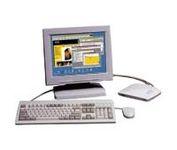
Unit with monitor, keyboard and mouse connected
|
|
Sony Vaio GR270P Laptop with 15” LCD screen.
Purchased new in November 2001.
Spec Sheet.
CPU:
Intel
Pentium III-M 1 GHz
512K L2
RAM: 512 MB
Storage:
Internal 30 GB IDE drive
Internal combo
DVD-ROM &
CD-R/RW
optical drive.
Display: 15" LCD-TFT 1024 x 768
resolution
Graphics: ATI Rage Mobility
Radeon-D 16 MB AGP
Audio: Stereo, built-in
speakers
Networking: 100
Megabit Ethernet, V.90 modem
Misc:
PC Card slots with
Cardbus support,
built-in
Sony Memory Stick drive, also
Firewire and USB 1.1
ports, TV-Out,
VGA out, parallel port.
Special
Hardware: Adaptec
SlimSCSI 1460 PC card
Linksys WPC55AG WiFi 802.11a/b/g
card
Belkin USB 2.0 PC card
External 1 GB
Jaz
drive (SCSI)
External flash card
reader (USB)
LG External DVD burner
(Firewire)
IDTECH
barcode LED gun scanner
Sony dock & port replicator
O/S:
Windows XP Professional (SP2)
Notes: This was my primary laptop until I purchased
the Dell 9300 in 2005. The
Sony was designed
for
video & audio work: It came bundled with a ton of
multimedia software including Sony's digital video
capture software, Sonic Foundry
Sound Forge,
Screenblast Acid and the 'lite' versions of Adobe
Premiere & Photoshop. Sony also threw in MS Word
2002 and Quicken for good measure.
The Mobility
Radeon graphics chip in this
machine is
powerful
enough to run early 2000s 3D games such
as Star Wars:
Episode I Racer (see picture at right).
The
amount of technological progress between the Toshiba laptop I purchased in '97 and
this one is remarkable. My '97 laptop ran at only 100 MHz, had
less than 1 GB of storage and no audio, optical disc
player or 3D graphics. This machine, made only
four years later, has a CPU clock speed ten times
faster,
has over thirty times more storage plus stereo
sound, a combo optical DVD player / CD burner and a Radeon 3D graphics
chip.
The
Pentium III-M
(code name "Tualatin") was the third
and best revision of the Pentium III architecture, with performance that matched or exceeded the early
Pentium 4s
while using significantly less power.
In
fact in 2006 Intel
discontinued development of the
Pentium 4 "Netburst"
line and switched to a new CPU
architecture partially based upon the Pentium III-M,
named
"Core".
Update 12/06: I purchased a new fast 60 GB 7200
rpm drive to replace the old 30 GB
4200 rpm unit, but haven't had time
yet to install it.
Update 10/07: Updated to XP SP2. Purchased high-
speed USB 2.0 card to better
support external hard drives.
|
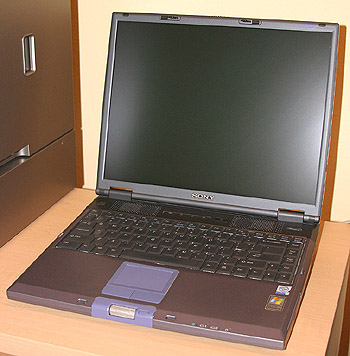
Larger version
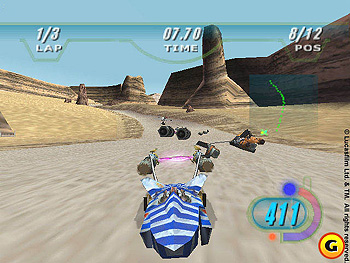
Larger version
(from Gamespot)
|
|
Compaq Deskpro EN Small Form Factor PC.
Built 2001; purchased used in March 2009.
CPU:
Intel Pentium III 1.0 GHz
Coppermine
RAM: 512 MB SDRAM PC133
Chipset:
Intel 815e
Storage: 20
GB Seagate
Barracuda ST320011A
Ultra ATA/100
7,200 rpm hard drive.
Lite-On LTN-486S 48x
CD-ROM
drive.
3.5" Floppy drive (1.44 MB)
Graphics:
Intel 82815 integrated graphics controller
Audio: Integrated
AC'97 Stereo with line in/out,
also front-panel microphone and
headphone jacks.
Networking: Integrated Intel Pro
Ethernet 10/100
Misc: 3
PCI
slots, 2
USB
1.1 ports,
1 serial
port, 1 parallel printer port.
O/S:
OpenSUSE Linux
11.1
This system cost
only $15 used but came without
an operating system installed.
Update 10/09: Increased
memory to the maximum 512 MB (using a recycled PC133 module
that cost $5), attached a Viewsonic 17" color CRT
monitor (cost $10) and installed the operating system OpenSuse Linux (free).
The screen shot at
right shows OpenSuse Linux on
the Compaq; the graphical user-interface is
KDE 4.1.
|
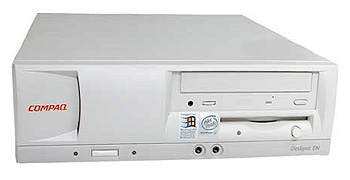
Larger version
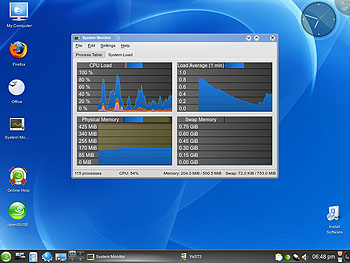
Linux
running on the Compaq (Larger version) |
|
Apple Power Mac G4 (Gigabit
Ethernet).
Built 2000; acquired January 2006.
CPU: Motorola
PowerPC G4 400 MHz
RAM: 1.5 GB
(expandable to 2 GB)
Storage:
One 20 GB ATA drive
One 80 GB ATA
drive
Internal
Superdrive DVD/CD burner
(Panasonic)
Internal
Zip drive
250 MB
Graphics:
ATI Rage Pro 128 AGP card with 16 MB
VRAM,
up to 1900x1200 @ 32 bits/pixel,
ADC and VGA
connectors.
Monitors:
Apple 17" LCD Studio Display
Apple 17" CRT Studio Display
Networking:
Gigabit
Ethernet
Misc: Adaptec
Ultra SCSI card, USB 1.1 &
Firewire 400 ports
O/S:
OS X 10.3 Panther &
OS 9.2
Notes This particular
model was the third revision
of the
Power Mac G4.
Released in August
2000, it
featured AGP graphics and Gigabit
Ethernet. Ever since the first Power Mac G4s
came out in
'99 I have wanted one
to play
with, but couldn’t justify the
expense since all
of my paying work is on
Windows
PCs. Years
later a very
nice client let me have this old
machine that they had
retired. This system
is pretty well equipped for an old G4 with 1.5
Gigabytes
of memory and OS X 10.3
(“Panther”).
Currently only four of my
systems have
Gigabit Ethernet - this Mac,
my
Business PC,
the
Playstation 3
and the
G4 'MDD' Power Mac.
The excellent
Apple History site has detailed
info on this
model
here.
Update 7/27/08: Replaced
original Apple DVD-ROM
drive with a Panasonic "Superdrive" DVD/CD burner.
Update 7/19/08:
Acquired a used
Apple 17" Studio
Display
in good condition for $30 (originally cost $500 when new). The monitor
is housed in a attractive
transparent case (see pic at right). The
Diamondtron
flat-screen CRT has a fine 0.25 mm grille pitch and
unusually supports a high 100+ Hz refresh rate. it
uses an ADC connection (video and power combined
into a single cable).
Later in 2008 I purchased the
LCD version of the
Apple Studio Display. This flat-panel display originally
sold for $1,000 new and is packaged in a beautiful
clear case with chrome trim. The display uses the
proprietary
ADC (Apple
Display Connector), which
carries both video and power in the same cable.
Luckily both of my G4s came with the special video
cards required for this to work.
|

Larger version
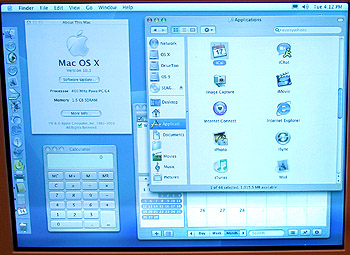
Larger version

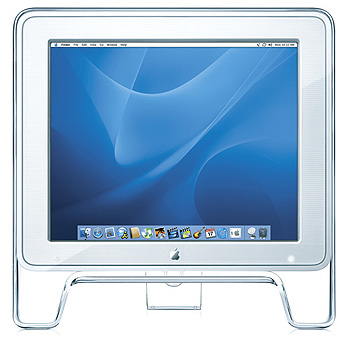
|
|
IBM eServer xSeries 230, Dual-Processors.
Manufactured in 2000, acquired in February 2009.
CPU:
Pentium III
1 GHz x 2
(dual CPUs)
RAM:
512 MB
ECC expandable to 4 GB
Graphics: S3
Savage4 integrated
with 8 MB VRAM
Storage:
Adaptec AIC-7899G
Ultra160
SCSI
dual
channel
integrated
controller.
IBM Netfinity ServeRAID-4L Ultra160
SCSI
RAID controller PCI 64-bit
card.
Three IBM 18.2 GB 10,000 rpm Ultra160
SCSI
slim-height drives in hot-
swappable
drive slots (six total).
Three additional drive bays for non-
swappable drives.
IBM integrated
Ultra DMA/33
IDE dual-
channel controller.
CD-ROM
40x
drive IDE.
3.5" 1.44 MB floppy drive.
Audio: PC speaker
built-in (sound card can be
added using the PCI slots).
Networking: 10/100
Megabit Ethernet
IBM integrated
AMD AM79C975.
Misc: 3
PCI 64-bit slots, 2 PCI 32-bit slots,
2
USB 1.1 ports,
2 serial ports, 1 parallel
port.
O/S: Currently
Windows 2000 Advanced
Server.
Monitor:
Dell 15" CRT
Notes:
My first industrial-strength server machine;
features dual
processors, 10,000 rpm hot-swappable
drives, error-correcting memory, 64-bit PCI slots,
a hardware RAID controller, can be run on either
110 or 220 volt power and is built like a tank.
The
IBM ServeRAID-4L
hardware RAID controller card
has an
Intel i960 100 MHz
processor and 16 MB ECC
cache memory. It supports up to
14 drives and a
dizzying array (pun intended) of
RAID modes
including 0 (striped disks), 1 (mirrored), 1E (two-way
mirroring), 5 (striped with parity), 5E (mode 5 with
integrated hot-spare), 10 (striped and mirrored) and
50 (striped with distributed parity).
|
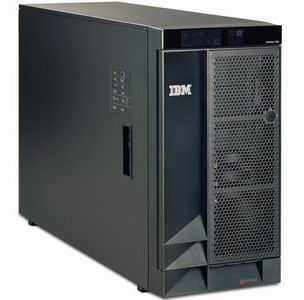
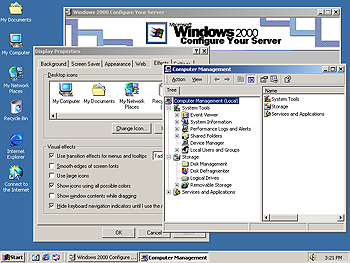
Windows 2000 Server desktop -
larger version.
See this and other Windows 2000 screen-shots
at the
GUIdebook
GUI collection.
|
|
Video Editing System, Dual-Processors.
Custom-built in 1999 (rebuilt in larger chassis in 2001).
CPU:
Pentium III 500 MHz x 2
(dual CPUs)
RAM:
1 Gigabyte (1,024 MB)
MB: Tyan
Tiger 100 S1832
Graphics: Hercules/Guillemot
Nvidia Geforce-256
DDR-DVI AGP card with 32
MB DDR
memory, VGA and DVI ports.
Storage:
Adaptec
39160 dual-channel ultra-160
SCSI controller card.
Internal 126 GB in four Quantum Atlas
10K 10,000 RPM drives
(72 GB used for
dedicated video array).
Asus 50x
CD-ROM
drive.
Audio: 4
audio channels in/out via DPS card
(see below).
Networking: 10/100
Megabit Ethernet
PS:
PC
Power & Cooling 425 watt Turbo-Cool
Special
Hardware: DPS Reality & Velocity
- high-end
professional
non-linear video editing
card and software,
able to do un-
compressed D1 (full broadcast-quality)
video capture, dual video stream
playback, 4 audio channels in/out,
on-board UW
SCSI controller.
Special
Software: DPS Velocity NLE, Eyeon Digital Fusion,
Adobe After
Effects 4.0 Production
Newtek Lightwave 3D 6.5, Bryce 3D 4.0.
Misc: 5
PCI slots, 2 ISA slots, 2 USB 1.1 ports,
2 serial ports,
parallel port.
O/S: Windows NT 4.0 Workstation and NT 4.0
Server (dual boot).
Monitor:
Sony GDM F500 21” flat-screen CRT.
Video
Equipmt: Sony Trinitron 20” NTSC program
monitor, Panasonic
AG1980
Professional S-VHS deck.
Notes: This machine was built to
professional video
editing standards and is
capable of outputting
uncompressed
broadcast-quality video.
|

Larger version
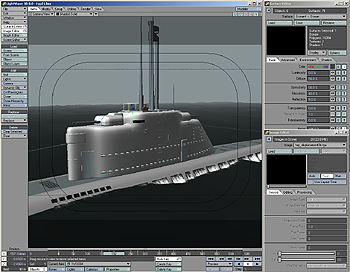
Lightwave 3D 8.0 (from
Lightwiki)
Larger version
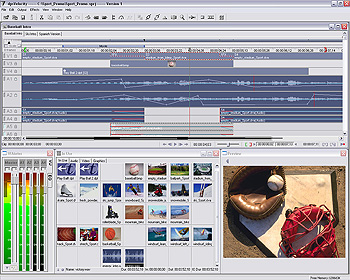
DPS Velocity
Larger version
|
|
Dell Dimension XPS T550.
Built 1999; purchased used in September 2005.
CPU: Intel
Pentium III 550 MHz
512K L2 cache
RAM: 384 MB (expandable to 768 MB)
Storage: 2 x 10
GB Western Digital WD100EB
ATA-100 5400 rpm drives
(20 GB total).
Sony
CD-RW CRX140E 32X/8X/4X
optical drive.
Toshiba
DVD-ROM
SD-M1212
6X
DVD /
32X CD
optical drive.
Sony 1.44 MB 3.5" Floppy drive.
Graphics: Diamond Viper V550
Nvidia TNT card
with 16 MB VRAM
(in AGP 2x slot),
capable of 1600 x 1200 pixels at millions
of colors.
Audio:
Yamaha XG 64 Voice sound
card, with
Altec Lansing speakers and sub-woofer.
Networking: US Robotics V.90 voice/fax
modem,
Kingston
10/100
Megabit Ethernet card.
Special
Hardware:
Quadrant CineMaster 3 DVD decoder
card with composite, s-video and
SPDIF
(Dolby AC-3) outputs.
PCMCIA to
PCI adapter card.
Misc: 2 USB
1.1 ports, 5 PCI slots (one
free), 1 ISA slot.
O/S:
OpenSUSE
Linux
11.2
Notes: I bought this machine in
2005 for
only $99 (it originally cost $2,600 new
six years earlier). The
previous owner removed the original hard drive before selling it for security reasons. I purchased a new 80GB hard drive for this system but ended-up
having to
use it for another project; I eventually got two old 10
GB drives from a good friend (along with an additional
128 MB memory module and an Ethernet card) to
finally get this machine up and running.
In the summer of 1999 this system
was the
top-of-the-line model from Dell, and was also on the top of
PC World's
list of "fastest" PCs.
Today no one would
call it
"super fast" but a Pentium III machine
is still
very useful for a variety of tasks.
This is the only
system I have that came with a
dedicated DVD hardware decoder card.
This is an
interesting artifact from the days when a system's
CPU and video card were not powerful enough to
decode and play back DVD video smoothly. The CineMaster
card takes care of decoding a DVD's
MPEG video and AC-3 audio streams, and has ports which can be used to directly output these
streams
to a TV
and a Dolby surround sound receiver.
This card also connects to the system's regular
video and audio cards via internal cables so that
DVD video & audio can be routed to the system
display and speakers. On more modern computers,
DVD decoding and playback is now done in software, with the MPEG video processed directly by the system video card.
Also unusual is the PCMCIA-to-PCI
adapter, this
allows laptop expansion cards to be directly plugged
in to this desktop PC.
1/25/09
Update: Purchased a used
Radius S-3F
15" 1024 x 768 LCD
monitor to use with this system
(cost $30).
11/29/09
Update: Finally got this machine
operational
by installing two used 10 GB hard drives, an additional
128 MB of RAM, an Ethernet card and OpenSUSE
Linux 11.2.
|
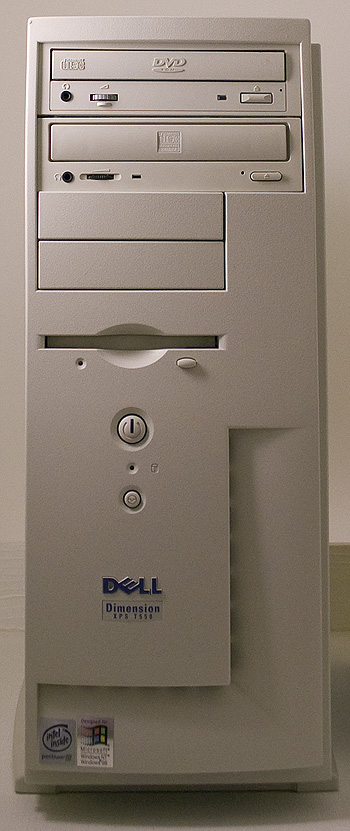
Larger version
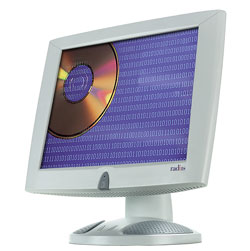
Radius S-3F monitor
|
|
Gateway
Essential 400c Micro-ATX Tower.
Built 1999; purchased used in February 2009.
CPU:
Intel
Celeron
400 MHz 128K L2 cache
socket 370 version ("Mendocino").
RAM: 32 MB (expandable to 256 MB)
Storage:
Maxtor 6
GB 5400 rpm hard drive
Acer
CD-ROM
56x
drive
Mitsumi 3.5" Floppy drive (1.44 MB)
Graphics: Integrated
ATI Rage 128 VR AGP
with 8 MB VRAM.
Monitor:
Gateway EV700 17" CRT
Audio: Creative Labs Sound Blaster
AudioPCI
128D with stereo line
in/out and
microphone connectors.
Networking:
Netgear Fast Ethernet
10/100 card,
Lucent V.90
winmodem.
Misc: 3 PCI slots
(1 free), 2
USB
1.1 ports,
1 serial port, 1 parallel
printer port,
1 game port.
O/S:
Windows 98 SE
Notes: I paid $20 for this
system including the monitor; the original system retail price was $1,000 in 1999.
The
Mendocino
Celeron was Intel's second generation 'budget' processor. With full speed cache memory
on-chip, this CPU is supposed to be almost as fast as
it's bigger and more expensive parent, the
Pentium II.
I intend to upgrade the memory, replace Windows 98
with a more modern O.S. and use this machine as a Lightwave render node
or for Linux.
|
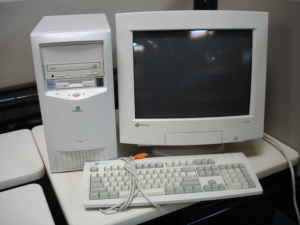

Windows 98 desktop -
Larger version
|
|
Desktop Business System – Dual-Processors.
Custom-built in 1998.
CPU:
Intel
Pentium II 450 MHz x 2 (dual CPUs)
RAM: 512 MB (expandable to 2 GB)
MB:
Tyan
Thunder 100 S1836DLUAN-GX
with Dual-Channel Ultra-Wide
SCSI
Graphics:
Nvidia TNT 16 MB
PCI
Monitor:
Viewsonic 21PS 21”
CRT
Storage:
Seagate
Cheetah 36 GB 10,000 rpm
Ultra-160 SCSI
drive, internal.
HP DVD200i DVDWriter
combo DVD+R
/RW and CD+R/RW
drive, internal.
Onstream DI30 30 GB
tape drive, internal.
Conner
Travan TR-3 3 GB tape drive,
internal.
Quantum Atlas 9 GB 7,200 rpm
Ultra-Wide SCSI drive, external.
Seagate
Scorpion DDS4 40 GB DAT
tape drive, external.
Audio: Creative Labs
Vibra 16XV 16-bit stereo
Networking: 10/100
Megabit Ethernet
PS:
PC
Power & Cooling 300 watt Turbo-Cool
Special
Hardware:
Adaptec combo USB 2.0 + Firewire card.
Canopus DVRaptor Firewire card.
Misc: 6
PCI slots, 1 ISA slot, 2
USB 1.1 ports,
2 serial ports, 1
parallel port.
O/S: Quad boot configuration:
Windows 2000 Professional
Windows XP Professional
Windows NT 4.0
Windows 98SE
Notes: This machine is ten years old
now but still usable thanks to it’s dual
CPUs and to the numerous upgrades that
have been done, such adding a DVD burner and a 10,000 rpm Cheetah drive.
While this system has four versions of Windows
installed, the one I used the most was Windows
2000 (see screen shot at right).
2007
Update: This machine is no
longer my primary business system. In March 2005 I
started using my Dell Inspiron laptop as my primary; then in 2007 I switched to the water-cooled super-system
that I built during my long-running 'next generation' computer project (see my 'Current Computers' page for details on that system).
9/24/11 Update:
Acquired used HP Pen Plotter (see
pic at right). Since only Windows 98 has a driver
for this printer I will likely attach it to this computer.
|
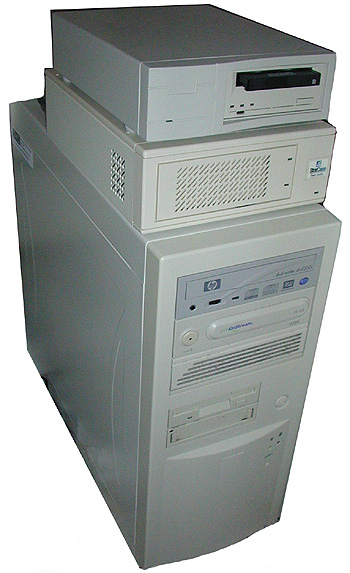
Larger version
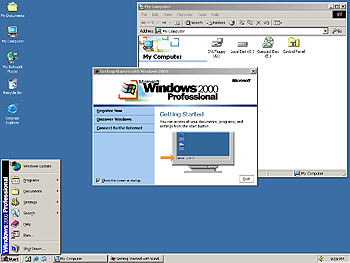
Windows 2000 desktop -
Larger version
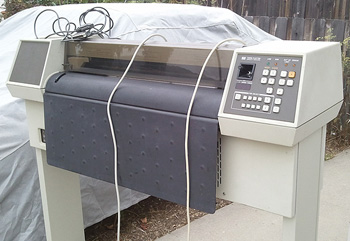
HP Plotter -
Larger version
|
|
Gateway E-4200 - Full Tower.
Built 1998; purchased used in November 2008.
CPU:
Intel
Pentium II
400 MHz
512K L2 cache
RAM: 384 MB
Storage: 10.1
GB
IBM Ultra-ATA/33 7200 rpm
hard drive.
Acer
CD-R/RW 4X/4X/32X drive
Sony
CD-ROM
drive
3.5" Floppy drive (1.44 MB)
Zip drive
100 MB
Graphics:
STB Powergraph/32
(S3 Trio32 chip)
PCI
card with 1 MB RAM.
One available
AGP slot.
Audio: None (can be added with expansion
card)
Networking:
Zoom Faxmodem
V.92
card
Best Data Ethernet 10/100
card
Misc: 4
PCI slots, 2
ISA
slots, 2
USB 1.1 ports,
2 serial ports, 1 parallel printer port.
O/S:
Windows XP Home
Notes: Bought this working machine used for
only $20; original retail price was around $2,000 in 1998.
With an 400 MHz CPU, 2D-only PCI graphics adapter
and no sound card,
this system
is not equipped to run modern games or
movies, but it is still useful for a
variety of business
tasks.
Historical note - unlike
most modern PCs, this model
could be
purchased from the factory
in three different
form factors - desktop,
mini-tower and
the version I
acquired, a full size tower.
12/20/08
Update: Increased RAM from 128 MB to
384 MB using memory salvaged from a non-working
iMac. Also purchased an Ethernet card for the
system (cost $10).
|
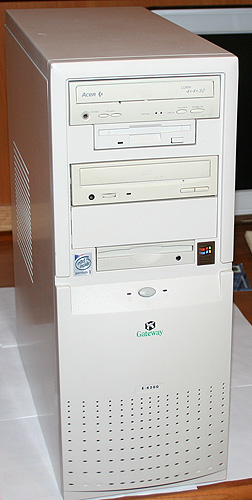
Larger version
|






































































